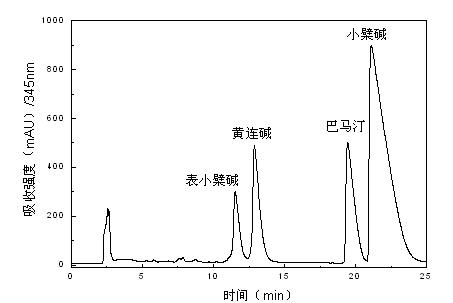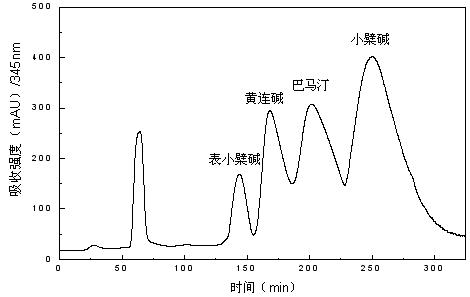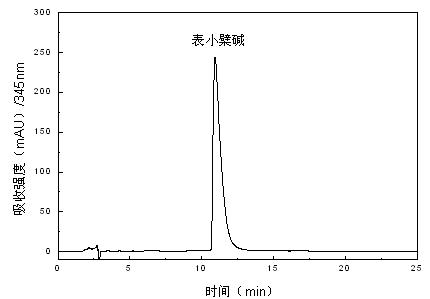Method for Separating and Purifying Monomer Compounds from Chinese Medicine Coptis Rhizoma
A technology for separation and purification of compounds, applied in the field of separation and purification of monomeric compounds, can solve the problems of inability to meet market demand, complex solvent system, small production scale, etc., and achieve the effect of shortening separation time, improving separation effect, and saving reagents
- Summary
- Abstract
- Description
- Claims
- Application Information
AI Technical Summary
Problems solved by technology
Method used
Image
Examples
Embodiment 1
[0029] Take 500g of crushed Coptis chinensis, add 8L of 40% ethanol, heat and reflux for 120 minutes, separate the residue and extract; add 6L of 40% ethanol to the residue and reflux twice, each time for 90 minutes, separate the residue and extract ; Combine the extracts obtained by refluxing the above three times, and recycle ethanol by distillation under reduced pressure to obtain the crude extract of Coptidis Rhizome.
[0030] Dissolve the crude extract of Coptis chinensis with 0.2L of 8.0% hydrochloric acid, let it stand for 36 hours, and then filter to remove the precipitate to obtain a solution; adjust the pH of the above solution to 8 with ammonia water, and add sodium carbonate to it until the concentration of sodium carbonate is 4%. , After standing for 24 hours, the precipitate was obtained by filtration, and the precipitate was dried to obtain the crude extract of coptis alkaloids.
[0031] N-butanol-phosphate buffer was used as high-speed countercurrent chromatogr...
Embodiment 2
[0033] Take 500g of crushed Coptis chinensis, add 6L of 55% ethanol, heat and reflux for 90 minutes, separate the residue and extract; add 6L of 55% ethanol to the residue and reflux twice, each time for 50 minutes, separate the residue and extract ; Merge the extracts obtained by reflux for the above 3 times, and reclaim ethanol by distillation under reduced pressure to obtain the crude extract of coptisine.
[0034] Dissolve the crude extract of Coptidis rhizome with 0.3L of 5.0% hydrochloric acid, let it stand for 36 hours and filter to remove the precipitate to obtain a solution; adjust the pH of the above solution to 10 with ammonia water, add sodium carbonate to it until the concentration of sodium carbonate is 0.5% , After standing for 36 hours, the precipitate was obtained by filtration, and the precipitate was dried to obtain the crude extract of coptis alkaloids.
[0035] Using n-butanol-phosphate buffer as the high-speed countercurrent chromatography two-phase solve...
Embodiment 3
[0037] Take 500g of crushed Coptis chinensis, add 3L of 80% ethanol, heat and reflux for 80 minutes, separate the residue and extract; add 3L of 80% ethanol to the residue and reflux twice, each time for 50 minutes, separate the residue and extract ; Merge the extracts obtained by reflux for the above 3 times, and reclaim ethanol by distillation under reduced pressure to obtain the crude extract of coptisine.
[0038] Dissolve the crude extract of Coptis chinensis with 2.0L of 0.4% hydrochloric acid, let it stand for 12 hours, and then filter to remove the precipitate to obtain a solution; adjust the pH of the above solution to 8 with ammonia water, and add sodium carbonate to it until the concentration of sodium carbonate is 0.4% , After standing for 24 hours, the precipitate was obtained by filtration, and the precipitate was dried to obtain the crude extract of coptis alkaloids.
[0039] N-butanol-phosphate buffer was used as high-speed countercurrent chromatography two-pha...
PUM
 Login to View More
Login to View More Abstract
Description
Claims
Application Information
 Login to View More
Login to View More - R&D
- Intellectual Property
- Life Sciences
- Materials
- Tech Scout
- Unparalleled Data Quality
- Higher Quality Content
- 60% Fewer Hallucinations
Browse by: Latest US Patents, China's latest patents, Technical Efficacy Thesaurus, Application Domain, Technology Topic, Popular Technical Reports.
© 2025 PatSnap. All rights reserved.Legal|Privacy policy|Modern Slavery Act Transparency Statement|Sitemap|About US| Contact US: help@patsnap.com



